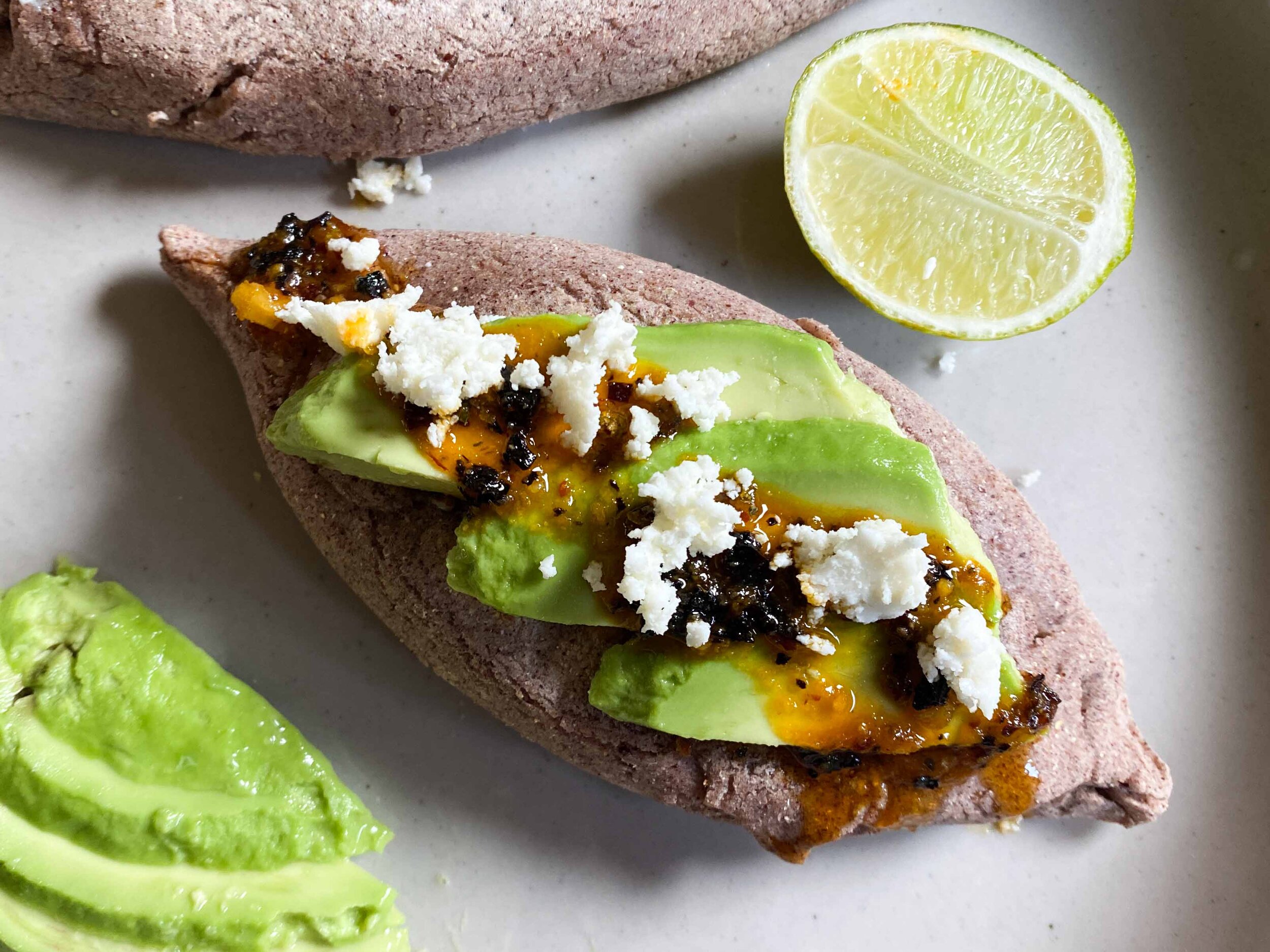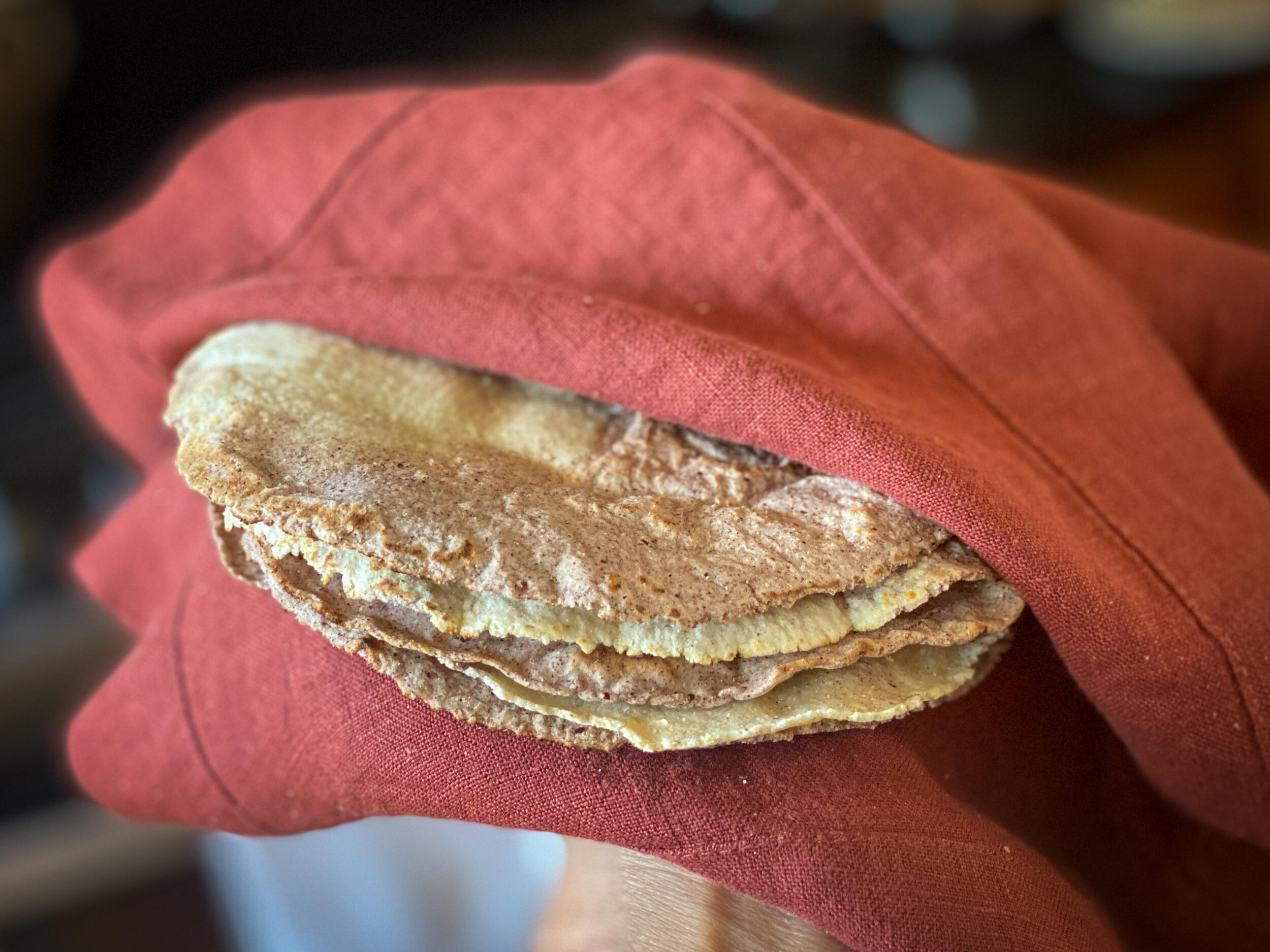By Leslie Brenner
[Editor’s note: This is first in a series of Cooks Without Borders stories (with recipes) about how to live the masa life. Find all The Masa Life articles here.]
Heirloom-corn masa + great beans = a new way to eat
In the old days, the before days, tuna salad sandwiches were the default lunch in our household at least twice a week. Maybe thrice.
Now we’re living the masa life — routinely making masa from masa harina (which takes all of about three minutes), pressing tortillas for tacos or tlayudas, folding tetelas or patting tlacoyos. These endlessly variable masa manifestations often become the vehicles for scratch refried beans, which have become a household staple. With simple enhancements like sliced avocado, a drizzle of always-in-the-fridge salsa macha, fresh herbs or a crumble of cheese, their simple pleasures are insanely satisfying. Add leftover roast chicken, salad greens, easy-to-make pico de gallo or salsa verde, grilled meats or fish or braised anything into the equation, and the delicious possibilities are infinite. We can also easily keep them plant-based, if that’s our desired vibe.
The life-change hasn’t come because I just learned how to make masa from masa harina (flour made from masa, the corn dough used to make all these shapes); I’ve been doing that for most of my life. It came because CWB’s resident Mexican cooking expert, Olivia Lopez, introduced me to two life-changing things: superior masa harina and a new way to think about beans.
We’ve already written about the bean part of the equation.
Now let’s dive into the maíz (corn) side.
Masa harina gets an upgrade
Although the handmade tortillas I used to make were much better than the corn tortillas I could buy in a supermarket, the mass-produced masa harina I was able to buy did not have much character, and I knew most of it was likely to involve genetically modified corn, which I was not happy to purchase or consume.
A fabulous new product on the market turns that equation on its head: masa harina made from heirloom corn from Mexico. Sourced from small farms, the non-GMO, landrace maíz is nixtamalized, milled and turned into masa harina by Masienda, a Los Angeles-based purveyor that supplies forward-looking chefs (including Olivia) from coast to coast. Get yourself a bag (it’s readily available online), stir in water, knead for a moment, and you’ve got shockingly good masa: the building block for all those shapes, and many others.
I’m not the only one who considers this new heirloom masa harina to be a game-changer for home cooks. Gonzalo Gout, one of the four authors (including super-chef Enrique Olvera) of the superb 2019 book Tu Casa Mi Casa: Mexican Recipes for the Home Cook, seems equally excited.
Because many of the recipes in Tu Casa Mi Casa are heavily reliant on masa, and the book was published just before the Masienda masa harina came on the market, I wondered if Gout would have seen its appearance as a game-changer, and what he thought of the product.
In an email, Gout — who along with his co-authors is involved in a number of the world’s most outstanding Mexican restaurants (including Pujol, Ticuchi and Eno (Mexico City), Criollo (Oaxaca), Cosme and ATLA (New York City), Damian (Los Angeles) — told me:
“We definitely cook with Masienda’s masa harina. I use it at home! Although we make all the fresh masa in-house at the restaurants because we are privileged enough to have a molino, we use the masa harina in dessert tuiles, in batters — like the fried fish taco at Damian — or to quickly dry up some overly wet masa. I mentioned it briefly in the book, but I genuinely believe that the problem with masa harina is not necessarily the process but the quality of corn behind it. Masienda solves that problem. For a home cook without access to a molino, making fresh tortillas from a good quality masa harina is far superior to buying industrial tortillas. Few things beat a fresh tortilla, and a good masa harina gets you pretty close to perfect.”
That’s so true, and the possibilities heirloom corn masa harina opens up for making tacos and tamales — and a whole bunch of other masa shapes — at home are cause for celebration:
Homemade tortillas have a life beyond tacos: Dry them out in the oven or on the comal until they’re crisp, and they become tostadas — a base for ceviches or salad-y assemblages.
Triangular tetelas are not-yet-cooked tortillas folded around a filling (often beans and cheese) then griddled on both sides. Simple and delicious, you can dress them up with salsas — or not.
Tlacoyos are eye-shaped masa patted or pressed a bit thicker than a tortilla and folded up along the middle also to enclose fillings. Flattened out before griddling, these make wonderful canvases for toppings like avocados or grilled sliced meats. If you make them in advance (including the griddling part), you can reheat them by pan-frying them, which makes the bottom wonderfully crispy.
Small, round masa cakes known as sopes are easy to form (no tortilla press necessary) and super versatile. A ridge around their edge holds fillings (beans, meats, cheese, salsas, etc.) in place.
My current obsession is the tlayuda, or rather a mini-version, a tlayudita. In its home in Oaxaca, a tlayuda is a pizza-sized corn tortilla griddled till it’s crispy-chewy, then spread with refried black beans while it’s still on the comal. Once off, it’s topped with meats, cheese, sliced tomato or radishes, or whatever you like.
The tlayudita: a deliciously chewy-crunchy little canvas
In coming stories, we’ll individually explore each of the above. For today, let’s talk more about the tlayuda/tlayudita. As long as you have a tortilla press, it’s easy to achieve and allows for endless improvisation with the toppings — much like a pizza.
Do a Google image search of “tlayudas in Oaxaca” and you get an instant sense of how they’re eaten and riffed on there: On top of the beans go any combination of cheese (often quesillo, Oaxacan string cheese), sliced tomatoes, crumbled chorizo or other meats, avocados. No doubt you’ll have your own ideas.
To make a legit tlayuda, you’d need a tlayuda press, which is like an oversized tortilla press — it’s a piece of equipment most of us home cooks do not own. (Though you could buy one if you’re deep-pocketed and dedicated to making full-sized tlayudas.) I’m sure it would be heresy to say this in Oaxaca, but I think a mini-version is just as nice — and you can use your regular tortilla press to make them.
Lately I’ve been loving a really simple tlayudita. Rather than black beans, I usually make refried mayocoba, bayo or mantequilla beans, as they cook much more quickly than frijoles negros. Their creaminess makes them ideal for quickly turning into quick vegan refritos. Just sweat a little chopped white onion and garlic in olive oil, add cooked beans and mash with a potato masher or bean masher, adding in some bean-cooking liquid as needed to get the right consistency. (I also keep cans of refried beans in the pantry for when I don’t have an hour or two to make mayacobas. Not as fabulous to be sure, but for quick lunches or weeknight dinners, I occasionally go that route.)
On top of that I arrange slices of avocado (a squeeze of lime sprinkled over), a drizzle of salsa macha, a few cilantro leaves. Inspired by a tlayudita I enjoyed at a wonderful cafe and masa shop in Brooklyn, For All Things Good, it makes a fabulous vegan lunch.
RECIPE: Avocado Tlayudita with Salsa Macha
Tlayudita with a garden vibe
My personal riffing often takes me more salady. I’ve become addicted to a version that’s like a cross between a tlayuda and a chicken tostada — a crispy-chewy tlayuda base spread with refried beans while it’s still on the comal, topped with a handful of tender salad greens, diced avocado, shredded chicken, cilantro, pico de gallo and a crumble of queso fresco. Even thinking about it puts me in a good mood.
RECIPE: Chicken Salad Tlayudita
Provisioning the masa life
Ready to start exploring the masa life by diving into tlayuditas? Get yourself some heirloom corn masa harina and (if you don’t already have one) a tortilla press. (Olivia has the one Masienda sells; it’s on my wish-list. We’re featuring that press in the Cooks Without Borders Cookshop, where you can also find an inexpensive starter model, the Masienda masa harina, and other cool tools and ingredients.) To cook the tlayuda base, a comal is great, but any griddle or cast-iron pan also works fine.
Then consider ingredients. If you fall in love with the masa life as quickly and irrevocably as we have, you’ll start stocking your pantry and fridge accordingly. Here’s what I try to keep on hand:
Dried beans — any or all of the following: mayocobas, bayos, mantequillas, frijoles negros, pintos (note that frijoles negros and pintos take longer to cook than the first three). I prefer to buy heirloom varieties of any of the above (Ranch Gordo is our favorite source), but even using supermarket beans is pretty great. If you cook up a big pot, you can have beans to quickly turn into refritos for the whole week.
A salsa or three: salsa macha, roasted salsa verde, salsa roja. I like to make my own salsa macha and roasted salsa verde, but you can also purchase them.
White onions, limes, serrano or jalapeño chiles, ripe tomatoes, cilantro, avocado, garlic, salt. Chop one ripe tomato with onion, serrano, cilantro and salt and you’ve got a fabulous pico de gallo. Avocados can be sliced or turned into guacamole or avocado purée, all great tlayudita toppings.
Salad greens for making my salady spin: spring greens, romaine (for shredding) or baby arugula.
A cheese or two. Queso fresco, quesillo and cotija are my masa-life faves; I find the best of those at a supermarket specializing in Mexican products. Confession: Mexican-style cheese blends usually lives in my fridge for when I run out of the first three. (Queso fresco doesn’t stay fresh very long.)
Here are some things I like to have on hand as well, but don’t find as essential:
Crema (Mexican-style sour cream) or American-style sour cream — these can be super nice to squiggle on for added richness.
Cooked chicken — I often pick up a supermarket roast chicken when I feel tlayuditas coming on. One breast is more than enough for two generous Chicken Salad Tlayuditas, and the rest of the chicken can be used for tacos. Or make an easy roast bird.
Dried avocado leaves or fresh epazote: One or the other is excellent for flavoring home-cooked dried beans.
Tomatillos — in case I want to blitz up a quick, fresh salsa verde in the blender.
Canned refried black or pinto beans — I buy organic ones. For when a tlayudita craving hits and I don’t have time to make dried beans.
A jar of store-bought salsa — for emergencies!
Got it? We can’t wait for you dive in. And we’re happy to answer any questions — about ingredients, techniques, equipment or whatever. Drop us a note in comments below. And look for the next installment of The Masa Life!
RECIPE: Avocado Tlayudita with Salsa Macha
RECIPE: Chicken Salad Tlayudita
READ: “How to make tetelas — those tasty, triangular masa packets that are about to become super trendy.”













